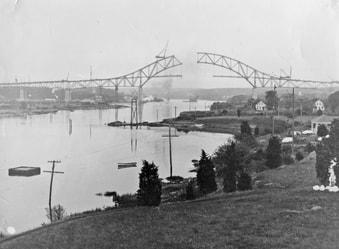The idea for a canal across Cape Cod dated back to the 17th century. In 1623, Pilgrim Governor William Bradford noted that such a canal would save time and distance for ships traveling between Boston and New York. Over the next two centuries, various plans were proposed for a canal, but none were ever built.
In the 1870s, a series of devastating shipwrecks off the coast of Cape Cod highlighted the need for a safer and more efficient shipping route. The Cape Cod Ship Canal Company was formed with the goal of building a canal across the Cape. The company encountered numerous obstacles, including financial difficulties, legal challenges, and technical problems. Despite these setbacks, the company completed a ditch across the narrowest point of the Cape in 1873. However, the canal was only 6 feet deep and not wide enough to accommodate large ships.
In 1909, August Belmont Jr., a wealthy financier, obtained a congressional charter to construct a new, privately-owned canal. Construction began in 1910 and was completed in 1914 at a cost of $11 million. The canal was 17.5 miles long, had a width of 100 feet and a depth of 25 feet, and included several locks and tidal gates. The construction of the canal was a massive undertaking that required the excavation of millions of cubic yards of earth, relocation of several towns, and the construction of numerous locks, bridges, and other infrastructure.
The canal was initially operated as a toll waterway, with ships paying a fee to use the canal. The tolls were controversial and led to disputes between the canal’s owners and the shipping industry. In 1928, the federal government purchased the canal and eliminated the tolls.
The U.S. Army Corps of Engineers widened and deepened the canal in the 1930’s. The bridges and locks were replaced and the new canal was opened in 1940 with a width of 480 feet and a depth of 32 feet. It was an immediate success, reducing the distance between Boston and New York by 62 miles and saving ships an average of 7 hours of travel time.
During World War II, the Cape Cod Canal played a vital role in the transportation of troops and supplies to the war effort. The canal was heavily guarded during the war, and several German U-boats attempted to attack ships passing through the canal.
In 1948, the canal was widened again to 540 feet, making it the wadest sea-level canal in the world. In the 1960s and 1970s, the canal was modernized with the addition of new navigation aids and electronic monitoring systems. In 1997, a new vertical-lift railroad bridge was built to replace the old bridge.
